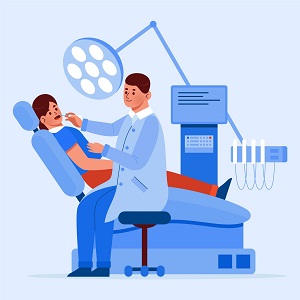Dental imaging equipment is essential in today’s dental practices, offering high-resolution images that are crucial for accurate diagnosis and effective treatment planning. This equipment includes a variety of devices, such as intraoral cameras, panoramic X-ray systems, cone beam computed tomography (CBCT) scanners, and 3D imaging systems. These advanced tools have significantly improved dental care by providing clear images of teeth, gums, and surrounding structures, which helps in early detection of dental problems like cavities, gum disease, and oral cancers.
Technological advancements have led to the development of digital imaging systems, which offer better image quality, reduced radiation exposure, and faster processing times compared to traditional film-based systems. Digital imaging also simplifies the storage, retrieval, and sharing of images, making it easier for dental professionals to collaborate and enhance patient care.
The growing demand for cosmetic dentistry and the increasing prevalence of dental diseases are driving the adoption of advanced dental imaging equipment. Additionally, the integration of artificial intelligence (AI) is further improving diagnostic accuracy and treatment outcomes. AI-powered tools assist in detecting abnormalities, predicting treatment success, and personalizing patient care.
Overall, the dental imaging equipment market is experiencing significant growth due to technological innovations, rising patient awareness, and a focus on preventive dental care. As the industry evolves, dental professionals will increasingly rely on innovative imaging solutions to deliver high-quality care and achieve better patient outcomes.
Get a sample copy of the report to know more https://medicalmarketreport.com/report/global-dental-imaging-equipment-market/#requestForSample
Key Market Segments
Type
Intraoral X-ray Systems
Intraoral Sensors
Extraoral X-ray Systems
Cone-Beam Computed Tomography (CBCT) Imaging
Intraoral Cameras
Application
Hospital
Ambulatory Surgical Centers
Independent Dental Clinics
Forensic Laboratories
Key Regions
- North America (The US, Canada, Mexico)
- Western Europe (Germany, France, The UK, Spain, Italy, Portugal, Ireland, Austria, Switzerland, Benelux, Nordic, Rest of Western Europe)
- Eastern Europe (Russia, Poland, The Czech Republic, Greece, Rest of Eastern Europe)
- APAC (China, Japan, South Korea, India, Australia & New Zealand, Indonesia, Malaysia, Philippines, Singapore, Thailand, Vietnam, Rest of APAC)
- Latin America (Brazil, Colombia, Chile, Argentina, Costa Rica, Rest of Latin America)
- Middle East & Africa (Algeria, Egypt, Israel, Kuwait, Nigeria, Saudi Arabia, South Africa, Turkey, United Arab Emirates, Rest of MEA)
Key Market Players included in the report:
Danaher
Planmeca
Carestream
Dentsply Sirona
VATECH
If You Have Any Questions About This Report, Please Reach Out to Us @ https://medicalmarketreport.com/report/global-dental-imaging-equipment-market/#inquiry
Drivers
- Increasing Dental Disease Prevalence
The rise in dental conditions like cavities and gum disease significantly drives the demand for advanced imaging tools. Early detection is essential for effective treatment, making these tools indispensable. - Advancements in Imaging Technology
Continuous innovation in imaging technology, such as digital systems and 3D imaging, propels market growth. These advancements offer superior image quality, reduced radiation, and faster processing times. - Rising Demand for Cosmetic Dentistry
The growing interest in cosmetic procedures fuels the need for precise imaging equipment. Accuracy is crucial in treatments like implants and veneers, where imaging tools play a vital role. - Growing Awareness of Preventive Care
There is a stronger focus on preventive care, leading to more regular dental check-ups. Consequently, this increases the demand for reliable and efficient imaging equipment.
Trends
- Adoption of Artificial Intelligence (AI)
AI integration in dental imaging equipment enhances diagnostic accuracy. For example, AI-powered tools can detect anomalies and personalize treatment plans, making them valuable in modern dentistry. - Shift to Digital Imaging
The market is moving from traditional film-based systems to digital imaging. Digital systems provide easier image storage and sharing, as well as quicker processing, benefiting dental practices greatly. - Growing Popularity of 3D Imaging and CBCT
3D imaging and CBCT are increasingly popular due to their detailed views of dental structures. These technologies are especially useful in complex cases like implant planning and orthodontics. - Portable Imaging Solutions on the Rise
The development of portable imaging devices is gaining momentum, particularly in remote areas. These solutions offer flexibility, allowing professionals to deliver quality care in various settings.
Opportunities
- Growth in Emerging Markets
Emerging economies offer significant growth opportunities. Increasing healthcare spending, growing awareness of oral health, and better access to dental care in regions like Asia-Pacific are driving expansion. - Aging Population
The global aging population leads to a higher prevalence of dental issues. This demographic trend creates sustained demand for advanced imaging solutions tailored to older adults’ specific needs. - Innovation in Imaging Technologies
Ongoing innovation in imaging technologies presents new opportunities. Developments in AI and augmented reality (AR) enhance dental imaging capabilities, opening avenues for market growth. - Focus on Patient-Centric Care
The shift towards patient-centered care encourages the adoption of advanced imaging tools. Features like customizable solutions and reduced radiation exposure appeal to both patients and practitioners.
Restraints
- High Costs of Advanced Equipment
The high cost of advanced imaging equipment is a major barrier, particularly for smaller practices. Maintenance, upgrades, and training add to the financial burden, limiting market access. - Strict Regulatory Standards
The market faces strict regulatory standards, which can slow the introduction of new products. Compliance requires significant time and resources, delaying innovation and market entry. - Limited Awareness in Developing Regions
Despite growth potential, limited awareness and adoption in developing regions pose challenges. Inadequate infrastructure and a lack of skilled professionals contribute to slower market penetration. - Radiation Exposure Concerns
Although modern imaging systems minimize radiation, concerns about long-term exposure persist. This can lead to hesitancy in adopting certain technologies, especially in preventive care settings.
Contact Us :
420 Lexington Avenue, Suite 300 New York City, NY 10170,
United States
Phone:+1 718 618 4351 (International),+91 78878 22626 (Asia)
Email: [email protected]



